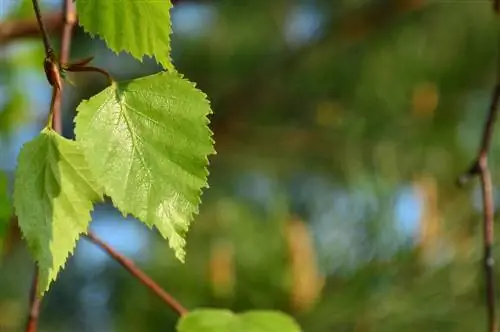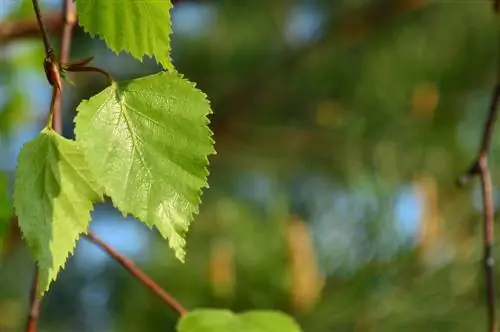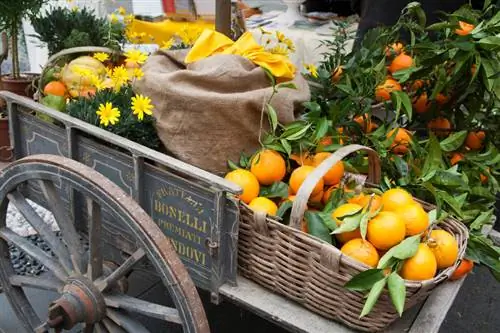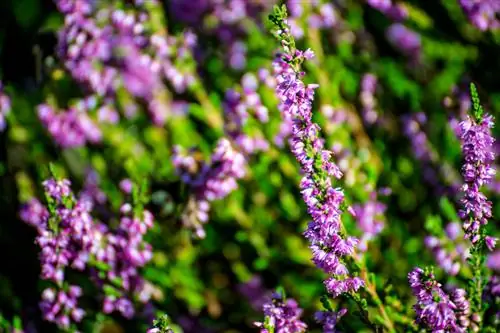- Author admin [email protected].
- Public 2023-12-16 16:46.
- Last modified 2025-01-23 11:21.
There are more than 40 different species of birch. Of course, the appearance of birch leaves is correspondingly wide-ranging. However, there are several similarities by which you can clearly recognize the leaf of a birch tree. Did you also know that you can even use the leaves of these picturesque trees for he alth and beauty?

What do birch leaves look like and what properties do they have?
Birch leaves are oval, slightly diamond-shaped to triangular leaves with jagged edges. They are colored in different shades of green and are often arranged in two rows. The leaves contain vitamins, essential oils and other beneficial substances that are used in tea, salads or cosmetics.
This is what birch leaves look like
When we generally talk about the leaf of the birch, this information refers to the widespread common birch. The Eurasian tree is found throughout Europe, with the exception of the extreme northern and southern areas. Its spread extends as far as Siberia. This Betula Pendula is known by various names. According to its profile, it is called white birch, sand birch or silver birch. While this is one and the same tree, there are numerous other forms of birch with beautiful names such as sugar birch or golden birch.
All birch leaves have a very classic characteristic: they have an oval, slightly diamond-shaped to triangular silhouette and are jagged at the edges. Depending on the species, the serrations can be stronger or weaker. The leaves, which are often arranged on short shoots, are divided into petioles and leaf blades. They usually occur alternately and are usually placed in two rows. Other general features:
- depending on the species 0.5 to (rarely) 14 centimeters long
- 0.5 to 8 centimeters wide depending on the species
- bald to slightly hairy
- Leaf edge is sawn to double sawn
- initially fresh green, later medium to dark green
- young leaves secrete sticky secretion via numerous resin glands
- on older leaves, whitish remains of the dried secretion
- balsamic aromatic scent, slightly bitter taste
Blue Birch
The blue birch actually owes its name to the slight blue tint of its strongly jagged leaves. Its blueish-green leaves merge into a reddish petiole. The rounded, egg-shaped leaf shape gives this birch a particularly decorative charm.
Yellow birch
The yellow birch gets its name not because of its leaves, but because of the yellowish color of the trunk. Their leaves, on the other hand, are a strong matt green. The double sawn edge of the leaf is striking.
Gold Birch
The widespread golden birch has yellow-green leaves. The silhouette of this birch leaf is egg-shaped with a distinctive tip and an equally striking sawn edge.
Paper Birch
The leaf of the paper birch is comparatively very long, up to 10 centimeters. Because it also tapers to a point, this birch leaf appears more elongated than the leaves of other birch species. Its color is intense dark green. The edge of the leaf is also sawn here.
Sugar Birch
The sugar birch also has egg-shaped, but rather elongated leaves up to 10 centimeters long and with a serrated leaf edge. The color is a bright, medium shade of green.
Downy Birch
The leaf of the downy birch, which is around 5 centimeters long, is quite medium in width and is significantly wider than the leaves of the other species listed as examples. It is heart-shaped with strongly serrated edges. Its silky, shiny surface also catches the eye.
Change in autumn
The color that the foliage of a birch tree takes on in autumn can also help to identify the leaves. The vast majority of birch leaves turn their strong green into a deep golden yellow as they transition to the cool season. In species such as the golden birch, whose leaves always have a slight yellowish undertone, the autumn color can be a warm orange tone.
Medicinal effects of birch leaf
Birch leaves contain many vitamins, especially the important vitamin C. Due to its essential oils as well as diuretic substances, flavonoids, saponins and tannins, the birch leaf has always been used for medicinal purposes. When brewed as a tea, birch leaves are used in detoxification treatments.
Appropriate infusions are also popular for balancing high cholesterol levels and helping you lose weight. Birch leaves are said to be helpful against the symptoms of inflammatory diseases such as rheumatism and gout because of their diuretic and anti-inflammatory effects. When used regularly, the leaf juice can prevent kidney and bladder stones - or completely eliminate existing ailments.
In fact, the entire leaves of the birch tree are edible - in contrast to the leaves of most other trees. In addition to using it as a tea, salads can also be used to channel the power of the birch leaf into the body.
Birch leaves in cosmetics
Birch tea is also used in a variety of ways in the field of body and beauty care. Its ingredients can be enjoyed internally or applied externally to help combat skin problems. These include rashes such as eczema or patchy areas, but also pimples and generally oily skin.
Used as a conditioner, the infusion of birch leaves can be integrated into hair care: the decoction can soothe the scalp and thus act against dandruff. Furthermore, a homemade birch leaf conditioner ensures shiny and supple hair.
Birch extracts are also effective in the fight against cellulite. Here they are mainly used dissolved in body oils. In addition, internal use should also support an even complexion in the typical problem areas.






